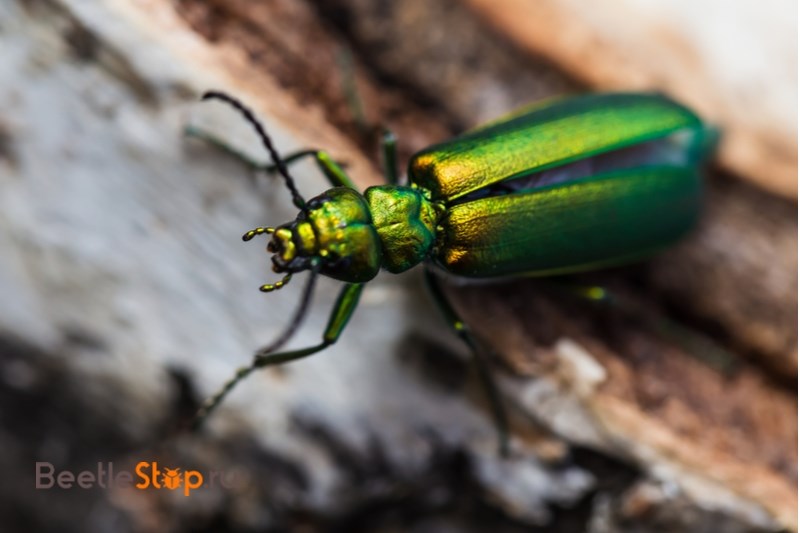Ashenic bastard - an attractive and dangerous beetle
Shpanki - a genus of buzzworm beetles that secrete the toxic substance cantharidin. A toxic substance causes skin irritation, and once in the body affects the nervous system. Dry ointment and an ointment patch are prepared from dry beetles; powder is used as an aphrodisiac. Ashenic rabbit or flypan is one of the most common species of the Lytta genus. Adult insects eat leaves and young shoots of trees. It is difficult to fight with mobile bugs, especially since their offspring parasitizes in the burrows of single bees.

Morphological description of the species
Ash-tree shpanka (Lutta vesicatoria) is a species from the bark family. A distinctive feature of insects is the content in the integument and liquids of the toxic substance cantharidin. The composition, which causes irritation of the skin, is used in medicine. An alcohol tincture and a powder are prepared from a flypan. The drugs are used in the treatment of inflammation of the bladder, kidneys, and uterus. Insect drugs in modern medicine have given way to synthetic products.
The main color of the beetle is green with a characteristic metallic luster. Sometimes individuals with a golden or copper tint occur. The dimensions of the body of imago: length 15-22 mm, width 4-5 mm. The head is heart-shaped, the occipital part is divided by a deep groove. The eyes are large, bulging. At the base of the eyes are long, filiform tendrils, consisting of 11 segments. The color is black, matte. Pronotum smaller than head in width, narrowed to base. The front corners are prominent.
Elytra flexible, elongated, shape close to rectangular. Leave the open tip of the abdomen. The hind wings are webbed, wide, well developed, transparent. When folded, they are hidden under the elytra.
Information. Adults have a specific unpleasant odor resembling mice. In case of danger, they secrete hemolymph drops from the joints of the limbs and antennae, as well as digestive secretions from the mouth.
The coxae of the forelimbs touch. The legs are long, well developed. Five-segmented foot with two tenacious claws, allowing you to run through the trees. The lower part of the body is densely covered with adjacent gray hairs. Head and pronotum in sparse standing hairs. The male has one spur on the front tibia, and two on the middle tibia.
Habitat
Beetles live in the forests of Southern and Western Europe, Kazakhstan. Ashenic creeper spread east to Central Asia and Siberia. In Russia, insects are found in the middle lane, in the Caucasus, Altai Territory and southern Siberia.
Imago lifestyle
Adult beetles are herbivorous insects. They feed on the crowns of ash, lilac, white willow, maple. Spankers prefer trees from the family of honeysuckle and olive. They hold in groups, having gathered in large numbers, completely expose the crown of the tree. In some cases, the foliage does not regenerate during the season, young plants in the nurseries dry up with such damage. Beetles appear in May, stay on the bright part of the crown. In closed forest stands they climb to the tops of trees. On the fringes and solitary trees are distributed over all branches.
Interesting fact. In many animals, cantharidin, secreted by bun, acts as a strong poison.But hedgehogs, hens, frogs and other amphibians eat beetles without harm to health.
Ash binder is active in sunny weather at temperatures above + 22 °. On cloudy days and evening hours, beetles sit quietly on the leaves. Insects mate on trees, for laying eggs, females descend to the ground. In the soil, dig holes in which 40-50 eggs are placed. In total, the female lays up to 1000 eggs per season. Larvae appear after 3-4 weeks.
Features of the development of larvae
The offspring of narijniki at a first age has a dark body with legs, antennae and tail threads. Moving insects triungulins climb onto flowers, where they cling to bees. Together with hymenoptera, they fall into their underground nests. Until the beginning of the 19th century, triungulin was considered to be parasites of bees without binding them to flies. The English scientist George Newport has established that these are the larvae of bomb guards. In the nest of bees, they eat eggs and larvae, then develop due to the supply of honey. Pupulate in the soil. Young beetles appear next year.
Methods of struggle
Insecticides are used to destroy beetles. Chemical treatment of trees is hampered by the activity of insects. Spray plants need at the time of detection of pests, otherwise they may fly to another area. An effective and safe method is mechanical shaking off of bobbins from branches. Early in the morning, while the film is laid out under the trees, it is cool. Hitting the branches with a pole, they knock down passive bugs on the litter, then destroy them.

